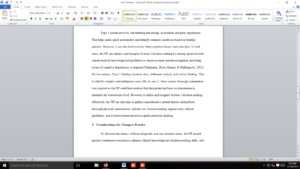Advanced Practice Nurse
Presumptive Seasonal Influenza
1. Dual Process Theory and Reasoning Process for Advanced Practice Nurse (APN):
2. Cognitive Dispositions to Respond (CDRs) in the APA setting.
3. Cognitive Debiasing
4. How to use Type 1 and Type 2 Processes in The Case Studies
5. Considerations for Change to Practice
Answer preview
Type 1 system involves fast thinking and relying on intuition and prior experiences. That helps make quick assessments and identify common conditions based on familiar patterns. However, it can also lead to errors when cognitive biases come into play. In both cases, the NP can enhance and integrate System 1 decision-making by staying updated on the current medical knowledge and guidelines to ensure accurate pattern recognition and being aware of cognitive dispositions to respond (Tsalatsanis, Hozo, Kumar, & Djulbegovic, 2015). On the contrary, Type 2 thinking involves slow, deliberate analysis and critical thinking. That is vital for complex and ambiguous cases, like in case 2, where a more thorough examination was required as the NP could have noticed that the patient had been on testosterone to minimize his testosterone level. However, to utilize and integrate System 2 decision-making effectively, the NP can take time to gather comprehensive patient history and perform thorough physical examinations, and also use decision-making support tools, clinical guidelines, and evidence-based practice to guide analytical thinking.
[671 Words]

Advanced Practice Nurse

